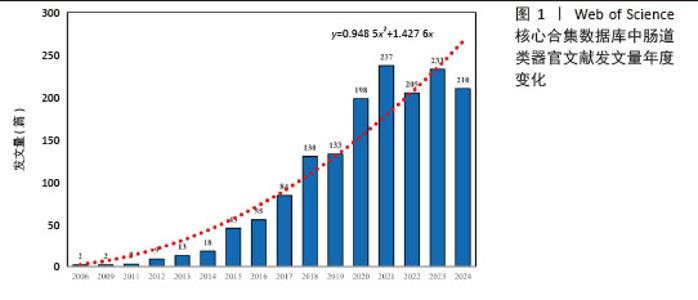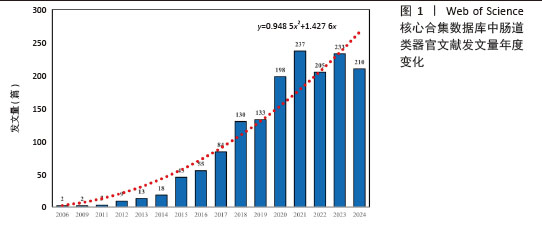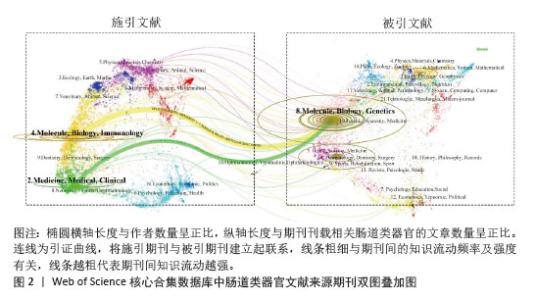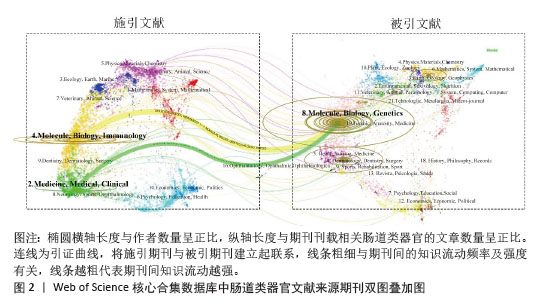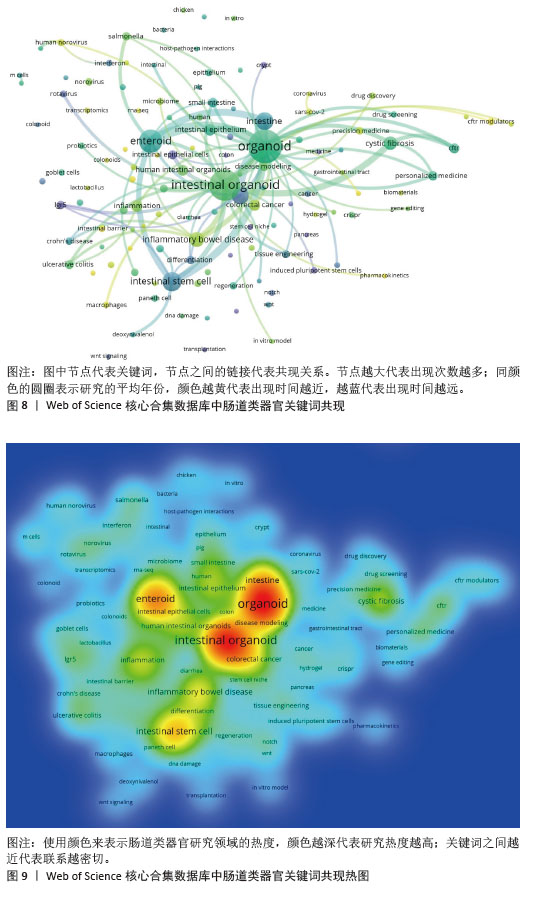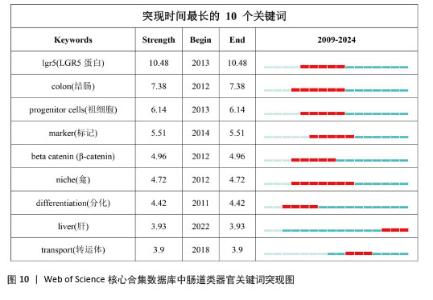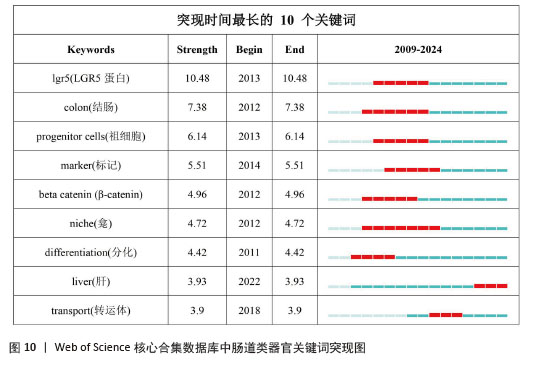Chinese Journal of Tissue Engineering Research ›› 2026, Vol. 30 ›› Issue (1): 238-247.doi: 10.12307/2026.542
Previous Articles Next Articles
Intestinal organoids: a bibliometric analysis of the latest trends in tissue/organ biology, disease modeling, and clinical applications
Zhao Qianwei, Sun Guangyuan
- Department of Emergency Trauma Surgery, First Hospital Affiliated to Hebei North College, Zhangjiakou 075061, Hebei Province, China
-
Received:2024-12-09Accepted:2025-02-13Online:2026-01-08Published:2025-07-02 -
Contact:Sun Guangyuan, MS, Associate chief physician, Department of Emergency Trauma Surgery, First Hospital Affiliated to Hebei North College, Zhangjiakou 075061, Hebei Province, China -
About author:Zhao Qianwei, MS, Department of Emergency Trauma Surgery, First Hospital Affiliated to Hebei North College, Zhangjiakou 075061, Hebei Province, China -
Supported by:Zhangjiakou Key R&D Project Program, No. 2121073D (to SGY)
CLC Number:
Cite this article
Zhao Qianwei, Sun Guangyuan . Intestinal organoids: a bibliometric analysis of the latest trends in tissue/organ biology, disease modeling, and clinical applications[J]. Chinese Journal of Tissue Engineering Research, 2026, 30(1): 238-247.
share this article
Add to citation manager EndNote|Reference Manager|ProCite|BibTeX|RefWorks
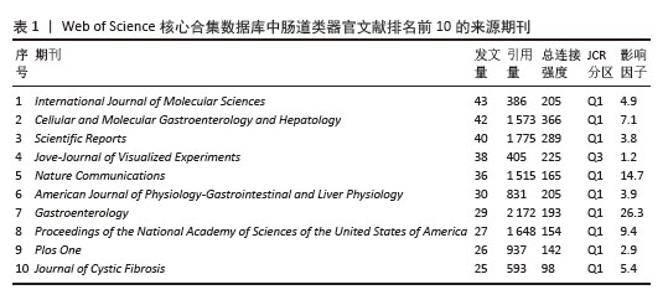
2.2 肠道类器官的期刊发表与双图叠加分析 为了全面了解肠道类器官领域的出版情况,分析了不同期刊和学科的文献分布。所有关于肠道类器官的论文来自501种期刊。如表1所示,发表论文最多的期刊是《International Journal of Molecular Sciences》(IF 2023=4.9),其次是《Cellular and Molecular Gastroenterology and Hepatology》(IF 2023=7.1)和《Scientific Reports》(IF 2023=3.6)。有趣的是《Gastroenterology》虽然发表肠道类器官文章数量并不是第一位,但引用量是最高的,达到2 172次引用。为进一步探索期刊之间,尤其是施引期刊与被引期刊之间的知识流动,作者运用了一种期刊双图叠加法[25],分析肠道类器官内在的联系,见图2。这种方法旨在识别从被引期刊到施引期刊的知识流动模式,并提供有关肠道类器官领域创新研究成果的高层次见解。该地图由Chen和Leydesdorff L设计,描绘了10 000多种科学期刊之间的相互联系,并将这些期刊进一步划分为代表学科出版和引用活动的区域。图2显示了 2006-2024 年间发表的有关肠道类器官文章的双图叠加。从引用(左侧)图开始到被引用(右侧)图结束的所有彩色曲线代表了引用链接的路径,最终确定了2条主要的引用路径。发表在 “分子、生物、遗传学”期刊上的论文经常被发表在 “分子、生物、免疫学 ”期刊和 “医学、医药、临床 ”期刊上的论文所引用。"
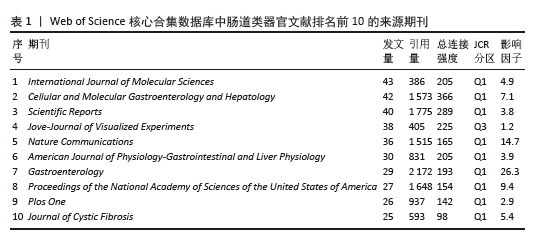
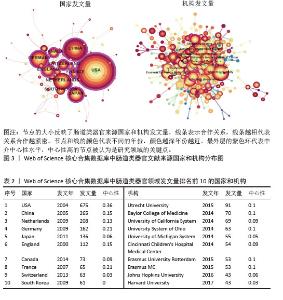
2.3 肠道类器官的国家机构分析 来自362个不同国家/地区的6 285 家机构在肠道类器官领域发表了论文。通过图3可以确定国家/地区和机构的影响力、爆发力以及主要热点。表2为肠道类器官领域发文量排名前10的国家/地区和机构,美国和中国发表的文章最多,甚至接近其他国家总和的2倍,其次是荷兰、德国和日本。由图3可见,发文量最高的10个国家中,美国(0.36)、德国(0.21)和英国(0.21)染成紫色,它们的中介中心性很高,一般认为这是一个重要的转折点,是一个桥梁结构,可能会带来革命性的发现。此外,发文量最高的10个机构中,乌特勒支大学(Utrecht University)发表的论文最多,其次是贝勒医学院(Baylor College of Medicine)和加州大学体系(University of California System)。图中连接圆圈的线条代表国际合作,线条越宽,合作越紧密。然而,大多数国家和研究机构都比较分散,缺乏一致和广泛的合作。 "
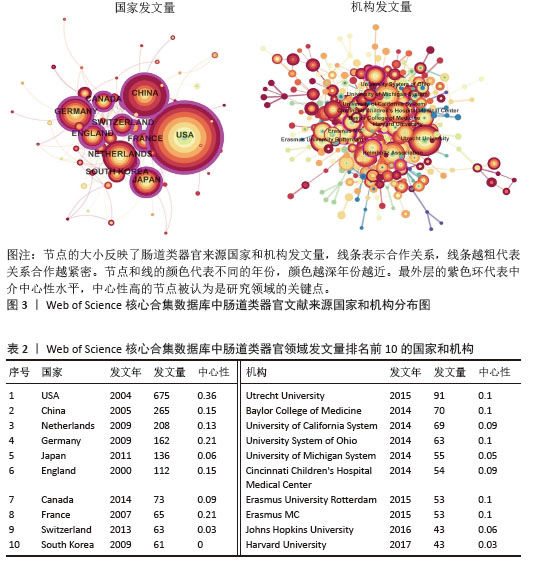
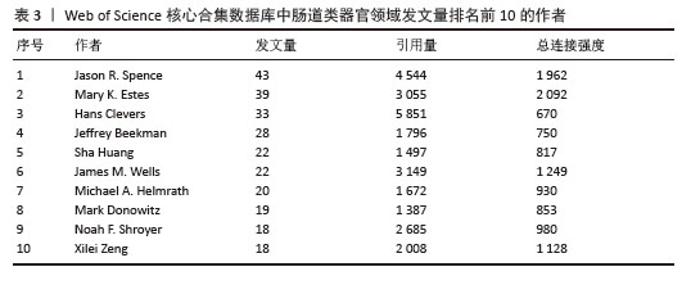
2.4 肠道类器官的作者合作网络分析 肠道类器官研究共有10 462位学者贡献,发文量前10位作者见表3,其中8名来自美国,2名来自荷兰。在发文量方面,美国密歇根大学的Jason R. Spence教授以43篇论文排名第一,其次是美国贝勒医学院的Mary K. Estes教授(39篇),再其次是荷兰乌得勒支大学医学中心的Hans Clevers教授(32篇)和Jeffrey Beekman教授(28篇),其他作者的发文量都少于30篇。从图4可以看出,肠道类器官的作者合作网络主要分为3个聚类,来自荷兰乌得勒支大学医学中心Hans Clevers(类器官之父)和Jeffrey Beekman为主要核心作为一个聚类;来自美国贝勒医学院Mary K. Estes,Noah F. Shroyer和Xi-Lei Zeng以及约翰霍普金斯大学Mark Donowitz为主要核心作为一个聚类;来自美国密歇根大学Jason R. Spence和Huang Sha为主要核心作为一个聚类;由此可以看出,有关肠道类器官核心竞争力的团队主要集中在美国和荷兰,其中荷兰作为肠道类器官发源圣地,主要开创了类器官技术在发育生物学、疾病病理学、细胞生物学、再生医学、精准医学以及药物毒性方面的应用;美国则集中在宿主病毒感染、高通量分析肠道微环境、再生医学等方面。虽然中国占据排名第二的总发文量,但并没有形成完善的作者合作网络与聚类核心,说明中国在肠道类器官方面研究较为分散,建议国家鼓励打造具有核心竞争力的科研团队。 "
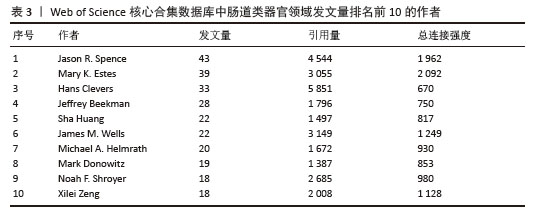
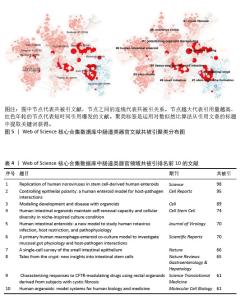
2.5 肠道类器官共被引分析 Small H于1973年首次提出了“共被引”(co-citations)的概念,随后这一概念被纳入文献共被引分析中,表明科学文献不是孤立的资源,而是一个相互联系、不断发展的系统[26]。假设2个或2个以上的参考文献经常被一起引用,那么这些参考文献显然存在着某种关联。事实证明,这种方法形成的网络图可以捕捉到潜在科学研究的重点。此外,网络聚类还能深入洞察整个研究领域的整合程度。参考文献共被引是CiteSpace的核心功能,它通过各种可视化属性来描述这类网络中的知识结构和动态演变[27]。该研究通过对1 577篇引用文章和10 462条有效参考文献的分析,确定了与肠道类器官研究相关的高被引文献的同质聚类。 图5显示了肠道类器官的共被引网络图,并标明了第一作者和被引用次数最多的参考文献的年份。每篇研究文章一般都引用了一些参考文献,这些参考文献在共被引网络图中表示为节点,节点的大小与引用频率呈正比,节点之间的链接代表了同一篇文章引用这些参考文献的频率。同样,线的粗细与共同引用频率呈正相关。表4列出了被引用次数最多的10 篇参考文献的更多信息。Ettayebi K等在2016 年共被引最多的参考文献是发表在《Science》上的一篇原创文章,题为“人诺如病毒在干细胞衍生的人肠道中的复制”[28],该研究创造性地利用人肠道类器官作为人类诺如病毒(human noroviruses,HuNoVs)体外感染系统,这一新培育系统的建立将促进在许多不同公共卫生重要领域的应用,如食品安全,开发新的诊断、疫苗和治疗方法,并推进对HuNoVs进化、免疫和发病机制的研究;其次是一篇题为“控制上皮极性:宿主-病原体相互作用的人类肠道模型”的文章[29],该研究开发了一种技术来逆转肠道极性,使肠微绒毛表面朝向培养递质,顶向外的肠上皮细胞保持适当的极性和屏障功能,并分化为主要的肠上皮细胞类型,表现出更容易接触吸收营养物质,利用这个模型来研究宿主-病原体的相互作用更有优势。此外,“用类器官模拟发育和疾病”引用也较高[30],这篇论文作为一篇综述,总结了3D培养类器官技术的最新进展,患者来源的类器官有望以个性化的方式预测药物反应。类器官为再生医学开辟了新的途径,并与基因编辑技术相结合为基因治疗开辟了新的道路。 "
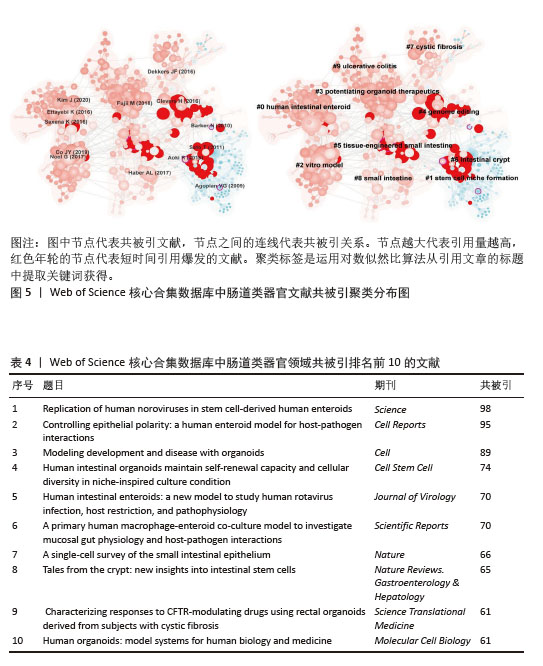
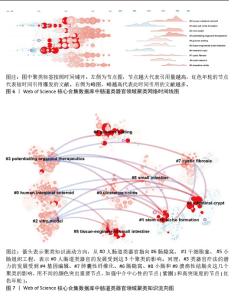
2.6 肠道类器官聚类网络 聚类网络分析可以挖掘研究领域的知识结构。根据CiteSpace软件中10 462 篇文章引用参考文献的共被引状态,如果2篇出版物有很多相似的参考文献,往往具有同质性,则会生成一个分层聚类网络。从1 577 篇文章的参考文献中提取的10个聚类如图5所示。聚类标签是使用对数似然比算法从引用文章的标题中提取的知名名词短语,包括#0人肠道类器官、#1干细胞龛、#2体外模型、#3类器官疗法的潜力、#4基因编辑、#5小肠组织工程、#6肠隐窝、#7肺囊性纤维化、#8小肠和#9溃疡性结肠炎。聚类标签的数量与每个聚类所包含的文章数量呈反比。聚类网络的模块化程度(Q值)表示网络可划分为聚类的程度,而剪影(S值)则是验证和解释聚类内部一致性的指标。如图5所示,总Q值为0.702 2,表明网络结构良好,且每个聚类的加权平均S值均在0.875 9 以上,表明聚类质量可信度高。此外,#0 人肠道类器官、#1干细胞龛和#6肠隐窝这3个集群涉及肠道类器官的研究基础和现状,而#3类器官疗法的潜力、#7肺囊性纤维化、#9溃疡性结肠炎这2个聚类集群则集中体现了肠道类器官的临床应用前景。 2.7 肠道类器官聚类网络知识流向分析 为了揭示随时间推移的研究趋势和热点,对共被引用的参考文献进行了聚类网络时间线分析(图6)。很明显,#0人肠道类器官群集的节点高度集中,引文从2012年开始爆发。#1 干细胞龛群集从 2006-2016 年持续了约10年。#3类器官疗法的潜力,引文从2017年开始爆发持续到现在而且还将进一步发展。为了进一步探究聚类网络之间的知识流向,对共被引文献进行了聚类依赖性分析(图7)。#0人肠道类器官、#2体外模型、#3类器官疗法的潜力作为新兴的聚类,其他7个聚类为此提供了基础。 "
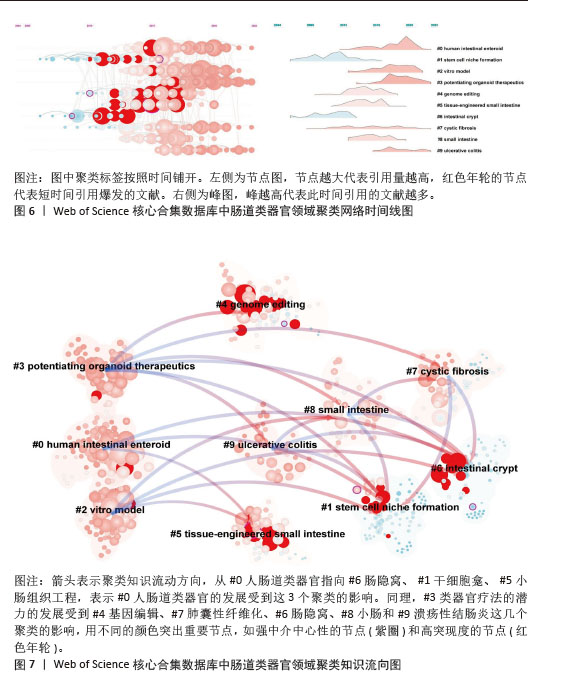
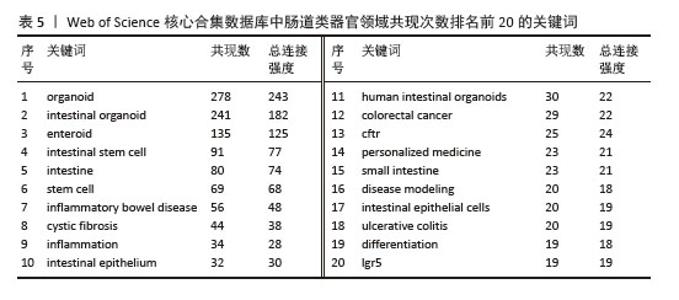
2.8 肠道类器官的新兴趋势:关键词共现分析 关键词是论文的核心,涵盖了论文的主要内容。在科学知识结构研究中,关键词可以准确识别研究前沿和热点,是文献计量学分析的有效方法。利用 VOSviewer 和 CiteSpace 软件进行了关键词共现(表5,图8,9)和突发关键词分析(图10),显示了肠道类器官相互相关主题。共提取了2 944个术语,其中165个术语出现超过 5 次,61个术语出现超过 10 次。关键词共现可视化(图8)可发现高频共现关键词,揭示了肠道类器官的研究热点。从图9和表5中可以看出,类器官是最重要的共现关键词,共出现278次,其次是肠道类器官、类器官、肠道干细胞、肠、干细胞和炎症性肠病。 此外,关键词的突现分析有助于发现尚未达到频率阈值但可能具有学术贡献的关键词,从而更全面地分析肠道类器官的热点和前沿。作为研究前沿课题的重要指标,CiteSpace被用来检测突发关键词。时间轴用蓝色线条表示,突发关键词的时间跨度用蓝色时间轴的红色部分表示。图10显示了引文爆发最强的前10个关键词。从 2009-2024 年,“Lgr5 ”是该领域的最强爆发关键词,其次是 “结肠”“祖细胞”和 “标记”。结果表明,近几十年来的研究越来越关注肠道类器官内在机制以及潜在的临床应用价值。 "
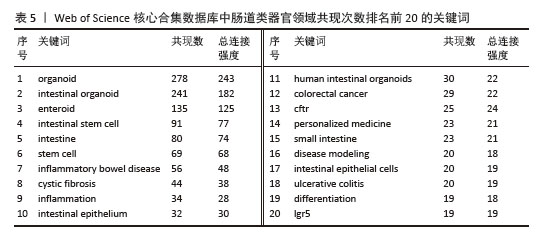
| [1] SHARKEY KA, MAWE GM. The enteric nervous system. Physiol Rev. 2023;103(2): 1487-1564. [2] 沈馨,孙志宏.微生物-肠-脑轴与神经系统疾病的研究进展[J].生物工程学报, 2021,37(11):3781-3788. [3] 徐菁,刘坤,马竹芳.Ibs患者神经内分泌轴功能与肠道菌群、炎症反应及胃肠症状的相关性[J]. 临床和实验医学杂志, 2023,22(4):360-364. [4] YAN M, MAN S, SUN B, et al. Gut liver brain axis in diseases: the implications for therapeutic interventions. Signal Transduct Target Ther. 2023;8(1):443. [5] PERDIJK O, AZZONI R, MARSLAND BJ. The microbiome: an integral player in immune homeostasis and inflammation in the respiratory tract. Physiol Rev. 2024; 104(2):835-879. [6] TAELMAN J, DIAZ M, GUIU J. Human Intestinal Organoids: Promise and Challenge. Front Cell Dev Biol. 2022;10:854740. [7] 孙广晨,李宏宇,陈江,等.类器官在生物医学中研究进展及应用[J].临床军医杂志,2023,51(11):1206-1210. [8] 强龙征,毛海光,王梦婷,等.肠道类器官在肠疾病机制研究中的运用[J].生物化学与生物物理进展,2024,51(2): 394-403. [9] SATO T, CLEVERS H. Growing self-organizing mini-guts from a single intestinal stem cell: mechanism and applications. Science. 2013;340(6137):1190-1194. [10] SMITH E, COCHRANE WJ. Cystic organoid teratoma; report of a case. Can Med Assoc J. 1946;55(2):151. [11] SATO T, VRIES RG, SNIPPERT HJ, et al. Single Lgr5 stem cells build crypt-villus structures in vitro without a mesenchymal niche. Nature. 2009;459(7244):262-265. [12] ETTAYEBI K, KAUR G, PATIL K, et al. Insights into human norovirus cultivation in human intestinal enteroids. mSphere. 2024;9(11):e0044824. [13] 李向阳,赵鑫,相小松,等.诱导型多能干细胞在体外三维环境中诱导分化出肠道类器官[J].中国组织工程研究, 2017,21(25):4057-4061. [14] BOUFFI C, WIKENHEISER-BROKAMP KA, CHATURVEDI P, et al. In vivo development of immune tissue in human intestinal organoids transplanted into humanized mice. Nat Biotechnol. 2023;41(6):824-831. [15] ZENK F, FLECK JS, JANSEN SMJ, et al. Single-cell epigenomic reconstruction of developmental trajectories from pluripotency in human neural organoid systems. Nat Neurosci. 2024;27(7):1376-1386. [16] SHINOZAWA T, KIMURA M, CAI Y, et al. High-Fidelity Drug-Induced Liver Injury Screen Using Human Pluripotent Stem Cell-Derived Organoids. Gastroenterology. 2021;160(3):831-846.e10. [17] QU M, XIONG L, LYU Y, et al. Establishment of intestinal organoid cultures modeling injury-associated epithelial regeneration. Cell Res. 2021;31(3):259-271. [18] YUAN L, XIE S, BAI H, et al. Reconstruction of dynamic mammary mini gland in vitro for normal physiology and oncogenesis. Nat Methods. 2023;20(12):2021-2033. [19] ODA M, HATANO Y, SATO T. Intestinal epithelial organoids: regeneration and maintenance of the intestinal epithelium. Curr Opin Genet Dev. 2022;76:101977. [20] HAYNES J, PALANIAPPAN B, TSOPMEGHA E, et al. Regulation of nutrient and electrolyte absorption in human organoid-derived intestinal epithelial cell monolayers. Transl Res. 2022;248:22-35. [21] AI S, LI Y, ZHENG H, et al. Collision of herbal medicine and nanotechnology: a bibliometric analysis of herbal nanoparticles from 2004 to 2023. J Nanobiotechnology. 2024;22(1):140. [22] LEYDESDORFF L, CARLEY S, RAFOLS I. Global maps of science based on the new Web-of-Science categories. Scientometrics. 2013;94(2):589-593. [23] CHEN C. Searching for intellectual turning points: progressive knowledge domain visualization. Proc Natl Acad Sci U S A. 2004;101 Suppl 1(Suppl 1):5303-5310. [24] VAN ECK NJ, WALTMAN L. Software survey: VOSviewer, a computer program for bibliometric mapping. Scientometrics. 2010;84(2):523-538. [25] CHEN C, LEYDESDORFF L. Patterns of Connections and Movements in Dual-Map Overlays: A New Method of Publication Portfolio Analysis. JASIS. 2014;65(2):334-351. [26] SMALL H. Co-Citation in the Scientific Literature: A New Measure of the Relationship between Two Documents. JASIS. 1973;24(4):265-269. [27] 常金霞,刘羽飞,牛少辉,等.巨噬细胞极化在组织修复过程中的可视化分析[J].中国组织工程研究,2025,29(7):1486-1496. [28] ETTAYEBI K, CRAWFORD SE, MURAKAMI K, et al. Replication of human noroviruses in stem cell-derived human enteroids. Science. 2016;353(6306):1387-1393. [29] CO JY, MARGALEF-CATALÀ M, LI X, et al. Controlling Epithelial Polarity: A Human Enteroid Model for Host-Pathogen Interactions. Cell Rep. 2019;26(9): 2509-2520.e4. [30] CLEVERS H. Modeling Development and Disease with Organoids. Cell. 2016; 165(7):1586-1597. [31] RECALDIN T, STEINACHER L, GJETA B, et al. Human organoids with an autologous tissue-resident immune compartment. Nature. 2024;633(8028):165-173. [32] CAPDEVILA C, MILLER J, CHENG L, et al. Time-resolved fate mapping identifies the intestinal upper crypt zone as an origin of Lgr5+ crypt base columnar cells. Cell. 2024;187(12):3039-3055.e14. [33] FOERSTER EG, MUKHERJEE T, CABRAL-FERNANDES L, et al. How autophagy controls the intestinal epithelial barrier. Autophagy. 2022;18(1):86-103. [34] WAKISAKA Y, SUGIMOTO S, SATO T. Organoid Medicine for Inflammatory Bowel Disease. Stem Cells. 2022;40(2):123-132. [35] CHEN Y, LU Z, FENG J, et al. Novel recombinant R-spondin1 promotes hair regeneration by targeting the Wnt/β-catenin signaling pathway. Acta Biochim Biophys Sin (Shanghai). 2023;55(8):1213-1221. [36] BUSTAMANTE-MADRID P, BARBÁCHANO A, ALBANDEA-RODRÍGUEZ D, et al. Vitamin D opposes multilineage cell differentiation induced by Notch inhibition and BMP4 pathway activation in human colon organoids. Cell Death Dis. 2024;15(4):301. [37] GOPALAKRISHNAN S, BAKKE I, HANSEN MD, et al. Comprehensive protocols for culturing and molecular biological analysis of IBD patient-derived colon epithelial organoids. Front Immunol. 2023;14:1097383. [38] MIYOSHI H, STAPPENBECK TS. In vitro expansion and genetic modification of gastrointestinal stem cells in spheroid culture. Nat Protoc. 2013;8(12):2471-2482. [39] MAYORGAS A, DOTTI I, MARTÍNEZ-PICOLA M, et al. A Novel Strategy to Study the Invasive Capability of Adherent-Invasive Escherichia coli by Using Human Primary Organoid-Derived Epithelial Monolayers. Front Immunol. 2021;12:646906. [40] YANG L, HAN L, LIU N. A New Approach to Journal Co-Citation Matrix Construction Based on the Number of Co-Cited Articles in Journals. Scientometrics. 2019;120(3): 507-517. [41] AN S, HUH H, KO JS, et al. Establishment and Characterization of Patient-Derived Intestinal Organoids from Pediatric Crohn’s Disease Patients. Pediatr Gastroenterol Hepatol Nutr. 2024;27(6):355-363. [42] CARTRY J, BEDJA S, BOILÈVE A, et al. Implementing patient derived organoids in functional precision medicine for patients with advanced colorectal cancer. J Exp Clin Cancer Res. 2023;42(1):281. [43] MAO Y, WANG W, YANG J, et al. Drug repurposing screening and mechanism analysis based on human colorectal cancer organoids. Protein Cell. 2024;15(4):285-304. [44] KROES S, BIERLAAGH MC, LEFFERTS JW, et al. Elexacaftor/tezacaftor/ivacaftor efficacy in intestinal organoids with rare CFTR variants in comparison to CFTR-F508del and CFTR-wild type controls. J Cyst Fibros. 2025;24(1):175-182. [45] WATSON CL, MAHE MM, MÚNERA J, et al. An in vivo model of human small intestine using pluripotent stem cells. Nat Med. 2014;20(11):1310-1314. [46] NAKANISHI A, TOYAMA S, ONOZATO D, et al. Effects of human induced pluripotent stem cell-derived intestinal organoids on colitis-model mice. Regen Ther. 2022;21: 351-361. [47] YUI S, NAKAMURA T, SATO T, et al. Functional engraftment of colon epithelium expanded in vitro from a single adult Lgr5⁺ stem cell. Nat Med. 2012;18(4):618-623. [48] MULERO-RUSSE A, GARCÍA AJ. Engineered Synthetic Matrices for Human Intestinal Organoid Culture and Therapeutic Delivery. Adv Mater. 2024;36(9):e2307678. [49] LLORENTE C. Isolation of Myenteric and Submucosal Plexus from Mouse Gastrointestinal Tract and Subsequent Co-Culture with Small Intestinal Organoids. Cells. 2024;13(10):815. [50] TSAI YH, NATTIV R, DEDHIA PH, et al. In vitro patterning of pluripotent stem cell-derived intestine recapitulates in vivo human development. Development. 2017;144(6):1045-1055. [51] SUGIMOTO S, KOBAYASHI E, FUJII M, et al. An organoid-based organ-repurposing approach to treat short bowel syndrome. Nature. 2021;592(7852):99-104. [52] JELINSKY SA, DERKSEN M, BAUMAN E, et al. Molecular and Functional Characterization of Human Intestinal Organoids and Monolayers for Modeling Epithelial Barrier. Inflamm Bowel Dis. 2023;29(2):195-206. [53] EDGAR RD, PERRONE F, FOSTER AR, et al. Culture-Associated DNA Methylation Changes Impact on Cellular Function of Human Intestinal Organoids. Cell Mol Gastroenterol Hepatol. 2022;14(6): 1295-1310. [54] LIU S, KUMARI S, HE H, et al. Biosensors integrated 3D organoid/organ-on-a-chip system: A real-time biomechanical, biophysical, and biochemical monitoring and characterization. Biosens Bioelectron. 2023;231:115285. [55] 胡亮,裴雪涛,李艳华.肠器官芯片构建技术及应用研究进展[J].军事医学, 2023,47(8):561-565. |
| [1] | Xu Canli, He Wenxing, Wang Yuping, Ba Yinying, Chi Li, Wang Wenjuan, Wang Jiajia. Research context and trend of TBK1 in autoimmunity, signaling pathways, gene expression, tumor prevention and treatment [J]. Chinese Journal of Tissue Engineering Research, 2026, 30(在线): 1-11. |
| [2] | Huang Jie, Zeng Hao, Wang Wenchi, Lyu Zhucheng, Cui Wei. Visualization analysis of literature on the effect of lipid metabolism on osteoporosis [J]. Chinese Journal of Tissue Engineering Research, 2026, 30(6): 1558-1568. |
| [3] | Zhang Haiwen, Zhang Xian, Xu Taichuan, Li Chao. Bibliometric and visual analysis of the research status and trends of senescence in osteoporosis [J]. Chinese Journal of Tissue Engineering Research, 2026, 30(6): 1580-1591. |
| [4] | Yang Zeyu, Zhi Liang, Wang Jia, Zhang Jingyi, Zhang Qingfang, Wang Yulong, Long Jianjun. A visualized analysis of research hotspots in high-frequency repetitive transcranial magnetic stimulation from the macroscopic perspective [J]. Chinese Journal of Tissue Engineering Research, 2026, 30(5): 1320-1330. |
| [5] | Peng Hao, Chen Qigang, Shen Zhen. A visual analysis of research hotspots of H-type vessels in various bone diseases [J]. Chinese Journal of Tissue Engineering Research, 2026, 30(3): 760-769. |
| [6] | Zhang Anqi, Hua Haotian, Cai Tianyuan, Wang Zicheng, Meng Zhuo, Zhan Xiaoqian, Chen Guoqian . Pain after total knee arthroplasty: current status and trend analysis [J]. Chinese Journal of Tissue Engineering Research, 2026, 30(3): 795-804. |
| [7] | Jiang Kan, Alimujiang·Abudourousuli, Shalayiding·Aierxiding, Aikebaierjiang·Aisaiti, Kutiluke·Shoukeer, Aikeremujiang·Muheremu. Biomaterials and bone regeneration: research hotspots and analysis of 500 influential papers [J]. Chinese Journal of Tissue Engineering Research, 2026, 30(2): 528-536. |
| [8] | Liang Haobo, Wang Zeyu, Ma Wenlong, Liu Hao, Liu Youwen. Hot issues in the field of joint revision: infection, rehabilitation nursing, bone defect, and prosthesis loosening [J]. Chinese Journal of Tissue Engineering Research, 2025, 29(9): 1963-1971. |
| [9] | Yuan Weibo, Liu Chan, Yu Limei. Potential application of liver organoids in liver disease models and transplantation therapy [J]. Chinese Journal of Tissue Engineering Research, 2025, 29(8): 1684-1692. |
| [10] | Lyu Liting, Yu Xia, Zhang Jinmei, Gao Qiaojing, Liu Renfan, Li Meng, Wang Lu. Bibliometric analysis of research process and current situation of brain aging and exosomes [J]. Chinese Journal of Tissue Engineering Research, 2025, 29(7): 1457-1465. |
| [11] | Xie Liugang, Cui Shuke, Guo Nannan, Li Aoyu, Zhang Jingrui. Research hotspots and frontiers of stem cells for Alzheimer’s disease [J]. Chinese Journal of Tissue Engineering Research, 2025, 29(7): 1475-1485. |
| [12] | Chang Jinxia, Liu Yufei, Niu Shaohui, Wang Chang, Cao Jianchun. Visualization analysis of macrophage polarization in tissue repair process [J]. Chinese Journal of Tissue Engineering Research, 2025, 29(7): 1486-1496. |
| [13] | Li Huijun, Li Huangyan, Zhang Yeting. Physical activity and cognition in older adults: research hotspot and topic evolution [J]. Chinese Journal of Tissue Engineering Research, 2025, 29(5): 1073-1080. |
| [14] | Dang Xiaowen, Huang Hailiang, Huang Lei, Wang Yajie . Research frontiers and hotspots of carbon nanomaterials in biomedical field over the past 10 years [J]. Chinese Journal of Tissue Engineering Research, 2025, 29(4): 752-760. |
| [15] | Ma Yucong, Ouyang Zhengzheng, Liu Xiaojie, Yang Sifei. Tracking of research trends and hotspots in medical magnesium alloy materials [J]. Chinese Journal of Tissue Engineering Research, 2025, 29(34): 7470-7480. |
| Viewed | ||||||
|
Full text |
|
|||||
|
Abstract |
|
|||||
